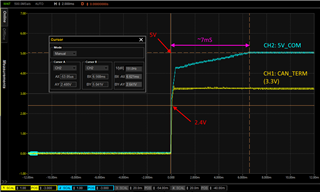Other Parts Discussed in Thread: SN74LVC1G17
Hi, I'm currently using TS5A3160 to switch 120-ohm termination on and off for CAN FD buses in our ESC (electronic speed controller) design.
This board is designed as an ESC (electronic speed controller) for the BLDC motor.
There's an external dip switch to toggle 3.3V on/off to feed 3.3V into TS5A3160 IN (pin 6) pin for switching.
Currently, the TS5A3160 is powered by 5V on V+.
I noticed a weird phenomenon during testing - after my motor control test running the BLDC motor, sometimes I cannot measure the terminating resistance across CAN_H and CAN_L. Only if I just power on the board and toggle the dip switch on, I can measure the 120ohm resistance across COM-NO (CAN_H/CAN_L). But TS5A3160 is only toggled via a mechanical dip switch. Is the resistance possible to measure with a multimeter?
Just in case, I also tried to capture if there's any voltage spike occurring on 3.3V/5V during motor operation causing the resistance cannot be measured phenomenon yet I couldn't find any anomaly on the waveform with an oscilloscope so far.
1) The first question is -
I'm wondering if TS5A3160 can detect logic high correctly in this setup? I checked Vih in the datasheet - when V+ is 5V, a minimum 2.4V should be present for it to be logic high. I assumed it should be fine detecting logic high. PS. Currently, there's no debounce circuit on the dip switch output signal but I'm thinking to add one. (The overshoot captured on CAN_TERM which is connected to pin 6 IN is 4V maximum when the dip switch is toggled but I want to eliminate the mechanical bounce.)
3) Is there any sequence requirement for the IN (pin 6) to V+? In the current design for this prototype, during my test, there's a possibility that when the USB is plugged into the ESC, the external USB 5V would convert to 3.3V and supply to pin IN. Only afterif I turn on the 24V from the power supply, the on-board 5V then will be converted from 10V on the board with an LDO.
4) The third question is - I have 2 boards, the TS5A3160 on them are either damaged or not functioning. (Most likely are damaged due to the chip is draining excessive current drained on 5V - somewhere around 54mA with calculation because 5V is converted by an LDO from 10V, 10V is converted by a switching regulator from 24V), after removing TS5A3160, the total current consumption is back to the same amount as the board that TS5A3160 is functional.
I'm worried this could be related to the mux chip damage (or not functioning properly) What are the possibilities that may have caused this failure- 1) chip damage? 2) cannot measure resistance after motor running but when first powering up I can measure the resistance across COM-NO (CAN_H to CAN_L) normally?
Would you kindly provide some insight into this potential TS5A3160 chip damage (or not functioning) issue and review the circuit around the TS5A3160 as attached? (There are 2 other muxes in the schematic SN74LVC1G3157DSFR for other PWM switching purposes. But currently, these 2 muxes are not populated and this function is not used, shown as DNP, please ignore that part of the section.)
And if my above description is unclear to you, please let me know where to address more.







